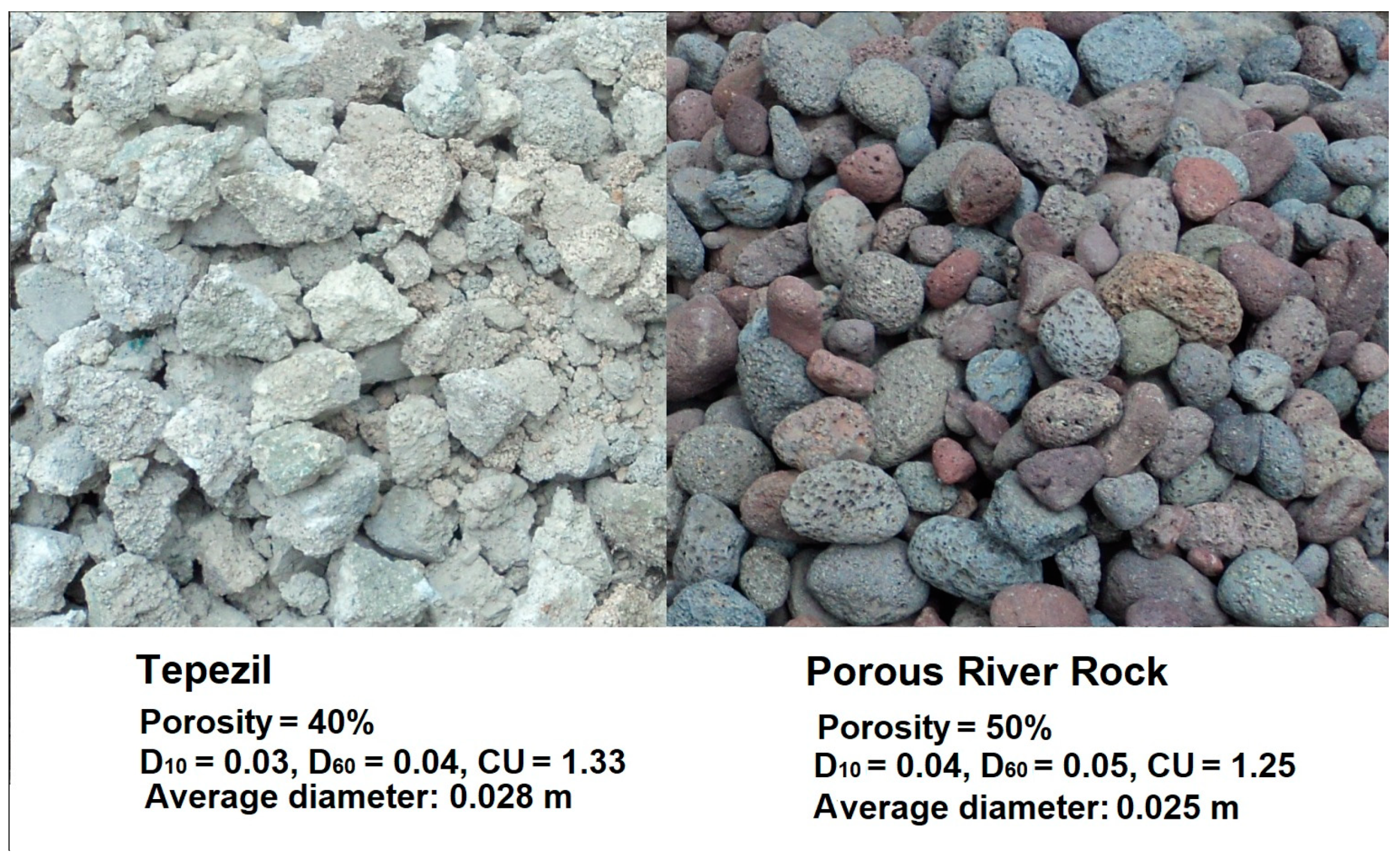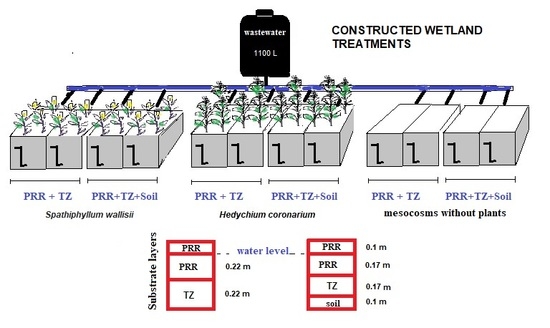Impact of Ornamental Vegetation Type and Different Substrate Layers on Pollutant Removal in Constructed Wetland Mesocosms Treating Rural Community Wastewater
Abstract
:1. Introduction
2. Materials and Methods
Design Features and Operating Criteria of Mesocosm
3. Results and Discussion
Concentration and Removal of Contaminants in CW Mesocosms
4. Conclusions
Author Contributions
Funding
Conflicts of Interest
References
- CONAGUA. Numeragua. Comisión Nacional del Agua. México. 2018. Available online: http://sina.conagua.gob.mx/publicaciones/Numeragua_2018.pdf (accessed on 7 August 2019). (In Spanish).
- Hernández, M.E. Ornamental wetlands with community participation for the improvement of municipal water in Mexico. Rinderesu 2016, 1, 1–12. Available online: http://rinderesu.com/index.php/rinderesu/article/view/16/32 (accessed on 6 July 2019). (In Spanish).
- Mitsch, W.J.; Gosselink, J. Wetlands; John Wiley and Sons Inc.: New York, NY, USA, 2015; Volume 5, p. 456. [Google Scholar]
- Wu, H.; Zhang, J.; Hao, H.; Guo, W.; Hu, Z.; Liang, S.; Fan, J.; Liu, H. A review on the sustainability of constructed wetlands for wastewater treatment: Design and operation. Bioresour. Technol. 2015, 175, 594–601. [Google Scholar] [CrossRef] [PubMed]
- García-García, P.L.; Ruelas-Monjardín, L.; Marín-Muñíz, J.L. Constructed wetlands: A solution to water quality issues in Mexico? Water Policy 2016, 18, 654–669. [Google Scholar] [CrossRef]
- Marín-Muñiz, J.; Humedales, L. Riñones del Planeta y Hábitat de Múltiples Especies; Editora de Gobiernodel Estado de Veracruz: Xalapa, Mexico, 2018. (In Spanish) [Google Scholar]
- Marín-Muñiz, J.L.; García-González, M.C.; Ruelas-Monjardín, L.C.; Moreno-Casasola, P. Influence of different porous media and ornamental vegetation on wastewater pollutant removal in vertical subsurface flow wetland microcosms. Environ. Eng. Sci. 2018, 35, 88–94. [Google Scholar] [CrossRef]
- Vymazal, J. Plants used in constructed wetlands with horizontal subsurface flow: A review. Hydrobiologia 2011, 674, 133–156. [Google Scholar] [CrossRef]
- Brix, H. Do macrophytes play a role in constructed treatment wetlands? Water Sci. Technol. 1997, 35, 11–17. [Google Scholar] [CrossRef]
- Zhang, L.; Lyu, L.; Zhang, Y.; Button, M.; Arias, C.A.; Weber, K.P.; Brix, H.; Carvalho, P.N. Impacts of design configuration and plants on the functionality of the microbial community of mesocosm-scale constructed wetlands treating ibuprofen. Water Res. 2018, 121, 228–238. [Google Scholar] [CrossRef] [PubMed]
- Lv, T.; Zhang, Y.; Zhang, L.; Carvalho, P.N.; Arias, C.A.; Brix, H. Removal of the pesticides imazalil and tebuconazole in saturated constructed wetland mesocosms. Water Res. 2016, 91, 126–136. [Google Scholar] [CrossRef]
- Kizito, S.; Lv, T.; Wu, S.; Ajmal, Z.; Luo, H.; Dong, R. Treatment of anaerobic digested effluent in biochar-packed vertical flow constructed wetland columns: Role of media and tidal operation. Sci. Total Environ. 2017, 592, 197–205. [Google Scholar] [CrossRef]
- Sandoval-Herazo, L.C.; Alvarado-Lassman, A.; Marín-Muñiz, J.L.; Méndez-Contreras, J.M.; Zamora-Castro, S.A. Effects of the Use of Ornamental Plants and Different Substrates in the Removal of Wastewater Pollutants through Microcosms of Constructed Wetlands. Sustainability 2018, 10, 1594. [Google Scholar] [CrossRef]
- Ding, Y.; Luy, T.; Bail, S.; Li, Z.; Ding, H.; You, S.; Xie, Q. Effect of multilayer substrate configuration in horizontal subsurface flow constructed wetlands: Assessment of treatment performance, biofilm development, and solids accumulation. Environ. Sci. Pollut. Res. 2018, 25, 1883–1891. [Google Scholar] [CrossRef]
- Bail, S.; Lyu, T.; Ding, Y.; Li, Z.; Wang, D.; You, S.; Xie, Q. Campus sewage treatment in multilayer horizontal subsurface flow constructed wetlands: Nitrogen removal and microbial community distribution. Clean Soil Air Water 2017, 45, 1700254. [Google Scholar] [CrossRef]
- Gorito, A.M.; Ribeiro, A.R.; Almeida, C.M.R.; Silva, A.M.T. A review on the application of constructed wetlands for the removal of priority substances and contaminants of emerging concern listed in recently launched EU legislation. Environ. Pollut. 2017, 227, 428–443. [Google Scholar] [CrossRef]
- Arden, S.; Ma, X. Constructed wetlands for grey water recycle and reuse: A review. Sci. Total Environ. 2018, 630, 587–599. [Google Scholar] [CrossRef]
- Marín-Muñiz, J.L. Removal of wastewater pollutant in artificial wetlands implemented in Actopan, Veracruz, Mexico. Rev. Mex. Ing. Química 2016, 15, 553–563. Available online: http://www.redalyc.org/articulo.oa?id=62046829021 (accessed on 30 July 2019).
- Marín-Muñiz, J.L.; Hernández Alarcón, M.E.; Moreno-Casasola, P. Greenhouse gas emissions from coastal freshwater wetlands in Veracruz Mexico: Effect of plant community and seasonal dynamics. Atmos. Environ. 2015, 107, 107–117. [Google Scholar] [CrossRef]
- Conover, C.A. Foliage plants. In Introduction to Floriculture; Larson, R.A., Ed.; Academic Press: Cambridge, MA, USA, 1992; pp. 569–601. [Google Scholar]
- APHA-AWWA-WEF. Standard Methods for the Examination of Water and Wastewater; American Public Health Association: Washington, DC, USA, 2005. [Google Scholar]
- Zhang, D.Q.; Tan, S.K.; Gersberg, R.M.; Zhu, J.; Sadreddini, S.; Li, Y. Nutrient removal in tropical subsurface flow constructed wetlands under batch and continuous flow conditions. J. Environ. Manag. 2012, 96, 1–6. [Google Scholar] [CrossRef]
- Cárdenas-López, D.; Baptiste, M.P.; Castaño, N. Familia Zingiberaceae Hedychium coronarium. In Plantas Exóticas con Alto Potencial de Invasión en Colombia 2010. Available online: http://hdl.handle.net/20.500.11761/32935 (accessed on 25 February 2019). (In Spanish).
- Vera, A.; Andrade, C.; Flores, E.; Núñez, M.; Cárdenas, C.; Morales, E. Remoción de nutrientes y materia orgánica en un humedal construido en función del desarrollo de la macrófita Typha dominguensis Pers. Rev. Técnica Fac. Ing. Univ. Zulia 2010, 33, 153–163. Available online: http://www.scielo.org.ve/scielo.php?pid=S0254-07702010000200006&script=sci_arttext&tlng=pt (accessed on 29 June 2019). (In Spanish).
- Vera, L.; Martel, G.; Márquez, M. First year performance of a new constructed wetland on the island of Gran Canaria: A case study. In Proceedings of the 12th International Conference on Wetland Systems for Water Pollution Control, Venice, Italy, 4–9 October 2010; International Water Association: London, UK, 2010; pp. 1037–1044. Available online: https://www.researchgate.net/profile/Luisa_Vera2/publication/288956774_First_year_performance_of_a_new_constructed_wetland_on_the_island_of_Gran_Canaria_a_case_study/links/56b3419008ae56d7b06ea7b0.pdf (accessed on 20 May 2019).
- Russell, D.L. Practical Wastewater Treatment; John Wiley & Sons: Hoboken, NJ, USA, 2019; Available online: https://books.google.com.mx/books?hl=es&lr=&id=F6mMDwAAQBAJ&oi=fnd&pg=PR17&dq=+in+Mexico,+monitors+water+bodies+have+established+that+an+acceptable+criterion+COD+discharge+biologically+treated+wastewater+must+not+exceed+40+mg/L+&ots=fGvreeyPSF&sig=t74EfHW3bcT7GLhmGNhjA6_BjHs#v=onepage&q&f=false (accessed on 15 June 2019).
- Wang, Q.; Hu, Y.; Xie, H.; Yang, Z. Constructed wetlands: A review on the role of radial oxygen loss in the rhizosphere by macrophytes. Water 2018, 10, 678. [Google Scholar] [CrossRef]
- Martínez, N.B.; Tejeda, A.; Del Toro, A.; Sánchez, M.P.; Zurita, F. Nitrogen removal in pilot-scale partially saturated vertical wetlands with and without and internal source of carbon. Sci. Total Environ. 2018, 645, 524–532. [Google Scholar] [CrossRef]
- USEPA. United States Environmental Protection Agency, Superfund Public Health Evaluation Manual; EPA/5401/1-86/060; USEPA: Washington, DC, USA, 1986.
- Sandoval, L.; Marín-Muñiz, J.L.; Zamora-Castro, S.A.; Sandoval-Salas, F.; Alvarado-Lassman, A. Evaluation of Wastewater Treatment by Microcosms of Vertical Subsurface Wetlands in Partially Saturated Conditions Planted with Ornamental Plants and Filled with Mineral and Plastic Substrates. Int. J. Environ. Res. Public Health 2019, 16, 167. [Google Scholar] [CrossRef]
- Sandoval, L.; Zamora-Castro, S.A.; Vidal-Álvarez, M.; Marín-Muñiz, J.L. Role of Wetland Plants and Use of Ornamental Flowering Plants in Constructed Wetlands for Wastewater Treatment: A Review. Appl. Sci. 2019, 9, 685. [Google Scholar] [CrossRef]
- Mazumder, D. Scope of BOD, nitrogen and phosphorous removal through plant-soil interaction in the wetland. Int. Sch. Sci. Res. Innov. 2012, 7, 104–113. [Google Scholar]
- Curtis, J.R.; Walbridge, M.R. Soil Chemistry and Phosphorous Retention Capacity of North Carolina Coastal Plain Swamps Receiving Sewage Effluent; Report 241; School of Forestry and Environmental Studies, Duke University: Durham, NC, USA, 1998. [Google Scholar]
- Wetzel, R. Limnología, 1st ed.; Omega: Barcelona, Spain, 1981; p. 679. [Google Scholar]



| Parameter Type | Sampling Frequency | Measured Parameter |
|---|---|---|
| Physical/hydraulic | Weekly | pH, temperature, flow * DO |
| Chemicals | Fortnightly | COD, TSS, N-NH4, N-NO3, P-PO4 |
| Parameter/Experimental Units | Influent | Spathiphyllum wallisii | Hedychium coronarium | Control | |||
|---|---|---|---|---|---|---|---|
| PPR | TZ | PPR | TZ | PPR | TZ | ||
| pH (pH units) | 7.6 ± 0.3 | 7.3 ± 0.3 | 7.2 ± 0.5 | 7.1 ± 0.9 | 6.9 ± 0.6 | 7.4 ± 0.2 | 7.3 ± 0.3 |
| DO (mg L−1) | 2.2 ± 0.3 | 4.6 ± 0.7 | 4.8 ± 0.6 | 4.7 ± 1.1 | 4.1 ± 0.4 | 2.6 ± 0.5 | 2.7 ± 0.3 |
| Temperature (°C) | 18.0 ± 0.9 | 19.6 ± 0.5 | 19.1 ± 1.9 | 17.8 ± 1.6 | 18.9 ± 0.9 | 20.0 ± 0.6 | 19.6 ± 0.5 |
| Parameter | Wetland Vegetation in Different Substrates | ||||||
|---|---|---|---|---|---|---|---|
| Spathiphyllum wallisii | Hedychium coronarium | Control | |||||
| PPR + TZ | PPR + TZ + Soil | PPR + TZ | PPR + TZ + Soil | PPR + TZ | PPR + TZ + Soil | ||
| COD | |||||||
| EC | 398 ± 39 | ||||||
| CS | 31 ± 11 | 36 ± 9.2 | 37 ± 9.6 | 35 ± 11.2 | 96 ± 11 | 91 ± 7.4 | |
| Removal (%) | 92.2 ± 6.8 a | 90.9 ± 0.8 a | 90.7 ± 12.3 a | 91.2 ± 10.2 a | 75.9 ± 14.4 b | 77.1 ± 11.2 b | |
| TSS | |||||||
| EC | 780 ± 72 | ||||||
| CS | 444 ± 82 | 426 ± 85 | 428 ± 76 | 460 ± 69 | 609 ± 69 | 618 ± 74 | |
| Removal (%) | 43.1 ± 11.2 a | 45.4 ± 7.9 a | 45.1 ± 6.5 a | 41.0 ± 9.6 a | 21.9 ± 6.4 b | 20.8 ± 8.2 b | |
| N-NO3 | |||||||
| EC | 14.4 ± 0.11 | ||||||
| CS | 8.4 ± 0.72 | 8.9 ± 0.18 | 8.6 ± 0.95 | 9.0 ± 0.98 | 11.1 ± 0.13 | 11.9 ± 1.0 | |
| Removal (%) | 41.7 ± 4.8 a | 38.2 ± 1.6 a | 40.3 ± 11.6 a | 37.5 ± 5.0 a | 20.8 ± 7.6 b | 17.4 ± 4.3 b | |
| P-PO4 | |||||||
| EC | 6.06 ± 0.64 | ||||||
| CS | 3.9 ± 0.19 | 2.79 ± 0.37 | 4.04 ± 0.26 | 2.96 ± 0.19 | 5.4 ± 0.34 | 4.6 ± 0.28 | |
| Removal (%) | 35.6 ± 1.2 b | 54.0 ± 2.9 a | 33.3 ± 3.1 b | 51.2 ± 2.6 a | 10.9 ± 0.8 d | 24.1 ± 1.5 c | |
| N-NH4 | |||||||
| EC | 4.11 ± 1.08 | ||||||
| CS | 2.32 ± 0.19 | 2.12 ± 0.33 | 0.98 ± 0.12 | 1.06 ± 0.66 | 3.2 ± 1.08 | 3.6 ± 0.75 | |
| Removal (%) | 43.6 ± 3.6 b | 48.4 ± 5.6 b | 76.1 ± 5.9 a | 74.2 ± 8.1 a | 22.1 ± 2.6 c | 12.4 ± 1.8 c | |
© 2019 by the authors. Licensee MDPI, Basel, Switzerland. This article is an open access article distributed under the terms and conditions of the Creative Commons Attribution (CC BY) license (http://creativecommons.org/licenses/by/4.0/).
Share and Cite
Zamora, S.; Sandoval, L.; Marín-Muñíz, J.L.; Fernández-Lambert, G.; Hernández-Orduña, M.G. Impact of Ornamental Vegetation Type and Different Substrate Layers on Pollutant Removal in Constructed Wetland Mesocosms Treating Rural Community Wastewater. Processes 2019, 7, 531. https://doi.org/10.3390/pr7080531
Zamora S, Sandoval L, Marín-Muñíz JL, Fernández-Lambert G, Hernández-Orduña MG. Impact of Ornamental Vegetation Type and Different Substrate Layers on Pollutant Removal in Constructed Wetland Mesocosms Treating Rural Community Wastewater. Processes. 2019; 7(8):531. https://doi.org/10.3390/pr7080531
Chicago/Turabian StyleZamora, Sergio, Luis Sandoval, J. Luis Marín-Muñíz, Gregorio Fernández-Lambert, and M. Graciela Hernández-Orduña. 2019. "Impact of Ornamental Vegetation Type and Different Substrate Layers on Pollutant Removal in Constructed Wetland Mesocosms Treating Rural Community Wastewater" Processes 7, no. 8: 531. https://doi.org/10.3390/pr7080531









